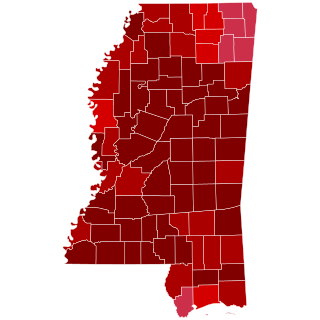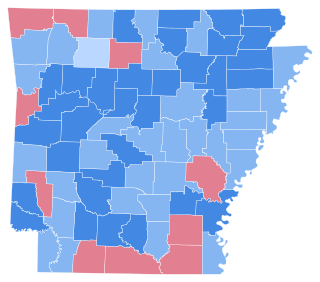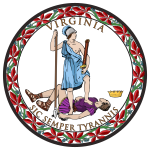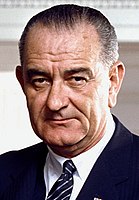
The 1964 United States presidential election was the 45th quadrennial presidential election. It was held on Tuesday, November 3, 1964. Incumbent Democratic President Lyndon B. Johnson defeated Republican Senator Barry Goldwater in a landslide victory. Johnson was the fourth and most recent vice president to succeed the presidency following the death of his predecessor and win a full term in his own right. Johnson won the largest share of the popular vote for the Democratic Party in history, 61.1%, and the highest for any candidate since the advent of widespread popular elections in 1824.

In American politics, the Southern strategy was a Republican Party electoral strategy to increase political support among white voters in the South by appealing to racism against African Americans. As the civil rights movement and dismantling of Jim Crow laws in the 1950s and 1960s visibly deepened existing racial tensions in much of the Southern United States, Republican politicians such as presidential candidate Richard Nixon and Senator Barry Goldwater developed strategies that successfully contributed to the political realignment of many white, conservative voters in the South who had traditionally supported the Democratic Party. It also helped to push the Republican Party much more to the right relative to the 1950s. By winning all of the South a presidential candidate could obtain the presidency with minimal support elsewhere.

The Solid South or the Southern bloc was the electoral voting bloc of the states of the Southern United States for issues that were regarded as particularly important to the interests of Democrats in those states. The Southern bloc existed between the end of the Reconstruction era in 1877 and the passage of the Civil Rights Act of 1964. During this period, the Democratic Party overwhelmingly controlled southern state legislatures, and most local, state and federal officeholders in the South were Democrats. During the late 1800s and early 1900s, Southern Democrats disenfranchised blacks in all Southern states, along with a few non-Southern states doing the same as well. This resulted essentially in a one-party system, in which a candidate's victory in Democratic primary elections was tantamount to election to the office itself. White primaries were another means that the Democrats used to consolidate their political power, excluding blacks from voting in primaries.

The Byrd machine, or Byrd organization, was a political machine of the Democratic Party led by former Governor and U.S. Senator Harry F. Byrd (1887–1966) that dominated Virginia politics for much of the 20th century. From the 1890s until the late 1960s, the Byrd organization effectively controlled the politics of the state through a network of courthouse cliques of local constitutional officers in most of the state's counties.

The politics of the Southern United States generally refers to the political landscape of the Southern United States. The institution of slavery had a profound impact on the politics of the Southern United States, causing the American Civil War and continued subjugation of African-Americans from the Reconstruction era to the Civil Rights Act of 1964. Scholars have linked slavery to contemporary political attitudes, including racial resentment. From the Reconstruction era to the Civil Rights Act of 1964, pockets of the Southern United States were characterized as being "authoritarian enclaves".

The 1964 United States presidential election in Alabama was held on November 3, 1964. Alabama voters chose ten representatives, or electors, to the Electoral College, who voted for President and Vice-President. In Alabama, voters voted for electors individually instead of as a slate, as in the other states.

The 1964 United States presidential election in Georgia took place on November 3, 1964, as part of the 1964 United States presidential election, which was held on that day throughout all 50 states and The District of Columbia. Voters chose 12 representatives, or electors to the Electoral College, who voted for president and vice president.

The 1960 United States presidential election in Virginia took place on November 8, 1960. Voters chose 12 representatives, or electors to the Electoral College, who voted for president and vice president.

The 1972 United States presidential election in Virginia took place on November 7, 1972. All 50 states and the District of Columbia were part of the 1972 United States presidential election. Virginia voters chose 12 electors to the Electoral College, which selected the president and vice president of the United States. This was also the first presidential election after the passage of the Twenty-sixth Amendment, which decreased the voting age from 21 to 18.

The 1968 United States presidential election in Virginia took place on November 5, 1968. All 50 states and the District of Columbia were part of the 1968 United States presidential election. Virginia voters chose twelve electors to the Electoral College, which selected the president and vice president of the United States.

The 1952 United States presidential election in Virginia took place on November 4, 1952. Voters chose twelve representatives, or electors to the Electoral College, who voted for president and vice president.

The 1948 United States presidential election in Virginia took place on November 2, 1948, throughout the 48 contiguous states. Voters chose 11 representatives, or electors to the Electoral College, who voted for president and vice president.

The 1932 United States presidential election in Virginia took place on November 8, 1932. Voters chose eleven representatives, or electors to the Electoral College, who voted for president and vice president.

The 1964 United States presidential election in Mississippi was held on November 3, 1964, as part of the 1964 United States presidential election, which was held on that day throughout all fifty states and the District of Columbia. Voters chose seven electors, or representatives to the Electoral College, who voted for president and vice president.

The 1964 presidential election in Arkansas was held on November 3, 1964 as part of the 1964 United States presidential election. State voters chose six electors, or representatives to the Electoral College, who voted for president and vice president. Incumbent President Lyndon B. Johnson won the state of Arkansas with 56.06% of the popular vote, which was a substantial increase upon John F. Kennedy's 50.19% from the preceding election, although the Republican vote remained virtually unchanged at 43.41%. Johnson won all but ten of Arkansas' seventy-five counties, and all four congressional districts. As of the 2020 presidential election, this is the last election in which Arkansas voted for a different candidate than neighboring Louisiana. Furthermore, with Mississippi, Alabama, Georgia, and South Carolina voting for Goldwater, Arkansas became the last Southern state to have never voted for a Republican candidate since the end of Reconstruction.

The 1968 United States presidential election in Mississippi was held on November 5, 1968. Mississippi voters chose seven electors, or representatives to the Electoral College, who voted for President and Vice-President. During the 1960s, the Civil Rights Movement dictated Mississippi's politics, with effectively the entire white population vehemently opposed to federal policies of racial desegregation and black voting rights. In 1960, the state had been narrowly captured by a slate of unpledged Democratic electors, but in 1964 universal white opposition to the Civil Rights Act and negligible black voter registration meant that white Mississippians turned almost unanimously to Republican Barry Goldwater. Goldwater's support for "constitutional government and local self-rule" meant that the absence from the ballot of "states' rights" parties or unpledged electors was unimportant. The Arizona Senator was one of only six Republicans to vote against the Civil Rights Act, and so the small electorate of Mississippi supported him almost unanimously.

The 1956 United States presidential election in Mississippi was held on November 6, 1956. Mississippi voters chose eight representatives, or electors to the Electoral College, who voted for president and vice president.

The 1964 United States presidential election in South Carolina took place on November 3, 1964, as part of the 1964 United States presidential election. South Carolina voters chose 8 representatives, or electors, to the Electoral College, who voted for president and vice president.

The 1964 United States presidential election in Maine took place on November 3, 1964, as part of the 1964 United States presidential election, which was held throughout all fifty states and D.C. Voters chose four representatives, or electors to the Electoral College, who voted for president and vice president.

The 1964 United States presidential election in West Virginia took place on November 3, 1964, as part of the 1964 United States presidential election. West Virginia voters chose seven representatives, or electors, to the Electoral College, who voted for president and vice president.


















